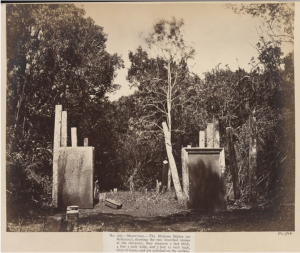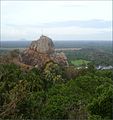OB03083 Poḷonnaruva Vēḷäikkāṟa Slab
Velaikkara Slab Inscription near the Atadage, Polonnaruwa
IN03103 Poḷonnaruva Slab Inscription of the Vēḷäikkāṟas
The inscription is incised on a fine granite slab found lying prone in the Tōpa-väva quadrangle (the Dalada Maluwa) in Polonnaruwa. The find was reported by H. C. P. Bell in his Annual Report of the Ceylon Archaeological Survey for 1903 (p. 11). The slab was subsequently framed with cement and placed upright near the Atadage in the Tōpa-väva quadrangle, where it stands today. Consisting of forty-nine lines in total, the inscription is written in Tamil with an introductory Sanskrit verse. It was erected by the members of the Vēḷäikkāṟa (or Velaikkara) community. As part of the expeditionary forces of Rājēndra Coḷa I, the Velaikkaras established themselves as a powerful force in northern Sri Lankan following the capture of Mahinda V in 1017–18 A.D. They were subjugated by king Vijaya-Bāhu I in 1073 A.D. but rebelled against his authority eleven years later, after he asked them to fight in his military campaign against their own kinsmen, the Coḷas. Although the king’s forces quickly quelled the rebellion, the Velaikkara community continued to hold considerable power. Indeed, such was their influence that, during the turbulent period of internal conflict that followed Vijaya-Bāhu I’s death, they were entrusted with the protection of the Sacred Tooth-relic Temple, which had been built (probably some twenty or thirty years earlier) by the minister Deva Senāpati under Vijaya-Bāhu’s orders. This inscription was erected around this time to provide written assurance that the Velaikkara soldiers would protect the sacred relics. The first part of the text serves as an introduction, describing Vijaya-Bāhu I’s charitable acts, including the building of the Tooth-relic temple. The second part details the provisions made by the Velaikkaras for the protection of the temple and relics. No date is given in the text but, drawing on a combination of palaeographic and historical evidence, Wickremasinghe argues that it dates from between 1137 and 1153 A.D., belonging either to the reign of Vikkama-Bāhu (1116–1137 A.D.) or, more probably, to that of his son Gaja-Bāhu (1137–1153 A.D.).
OB03063 Poḷonnaruva Kāliṅga Forest Gal-āsana
The Quadrangle (Dalada Maluwa), Polonnaruwa, Sri Lanka
IN03083 Poḷonnaruva Kāliṅga Forest Gal-āsana Inscription
The inscription is engraved around four sides of the smoothed upper surface of a granite seat or āsana. In 1927, Wickremasinghe reported that the seat stood a few feet off the south-east corner of the site of a Piḷima-gē (‘image-house’) in the group of ruins on the Tōpa-väva quadrangle (the Dalada Maluwa) in Polonnaruwa. The inscription indicates the āsana as that on which king Niśśaṅka-Malla used to sit whenever he witnessed the dramatic and musical entertainments which were held in the Kāliṅga-vana after his return from his Ceylong tours and his Indian campaign. Niśśaṅka Malla reigned from 1187 to 1196 A.D. According to the Poḷonnaruva Häṭa-dā-gē Vestibule Wall Inscription (IN03079), Niśśaṅka Malla began his journeys around Ceylon in the second year of his reign i.e. 1188-89 A.D. As the present inscription refers to these journeys, it must date from after 1188 A.D.
OB03025b Mihintale Tablet B
OB03025a Mihintale Tablet A
OB03025 Mihintale Tablets of Mahinda IV

Mihintale. The Bhójana Sáláwa (or Refrectory), showing the two inscribed stones at the entrance. Photographed by Joseph Lawton (d. 1872) active in Sri Lanka between 1866 and 1872. V&A 82756
IN03030 Mihintale Inscription of Mahinda IV
The inscription is written on two granite slabs, which stand near the old refectory, also called Bhōjana-sālā, on the left of the third set of steps (on four) on the western slope of the hill at Mihintale. The inscription is divided equally between the two slabs, each one bearing 58 lines of Sinhalese prose. They were installed by the king Mahinda IV (975-91 A.D.) and record rules and regulations for the administration of the monastery (the name of the monastery is not mentioned) and payments made to the service staff.
OB03006 Jētavanārāma Slab
IN03007 Jētavanārāma Sanskrit Inscription
The inscription was discovered in ruins of an ancient monastery belonging to the Jētavanārāma group, north of the Kūṭṭam-pokuṇa in Anurādhapura. It consists of 14 lines of Sanskrit prose engraved on a granite slab. It seems to be the second portion of a text. The first part must have been written on another slab, which has not been found. The inscription records rules for the guidance of monks and laymen living in within the precincts of the vihāra or in its lands. No date is given in the inscription but, according to Wickremasinghe, it is probably from the first half of the 9th century A.D.


